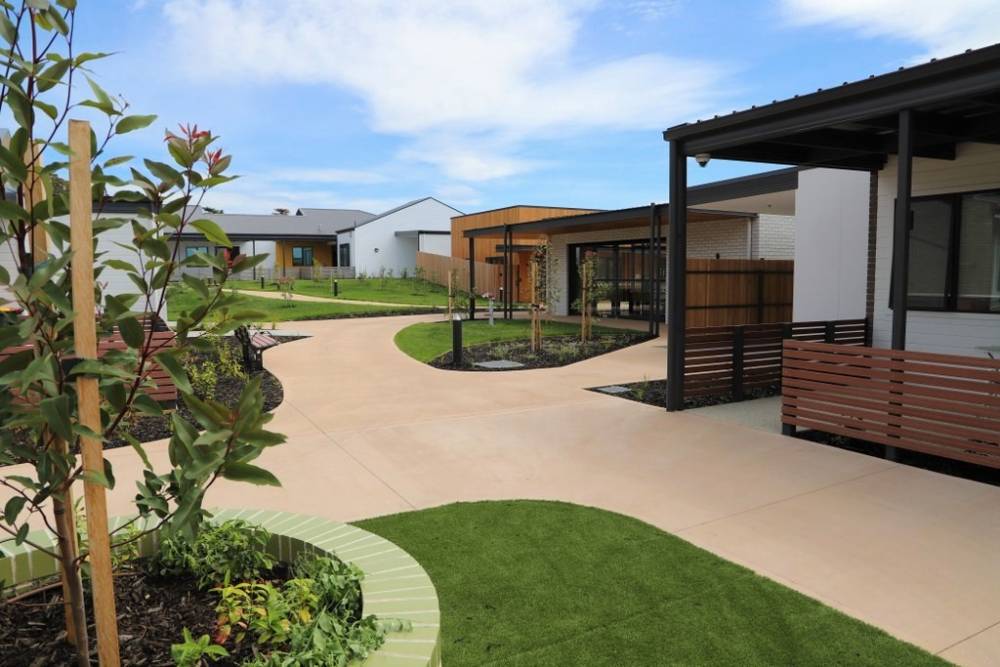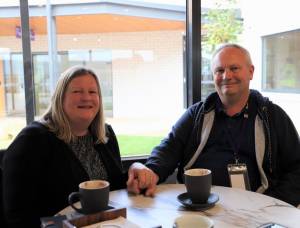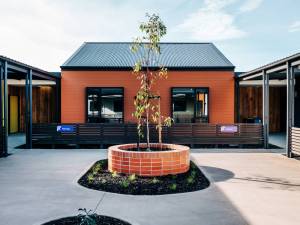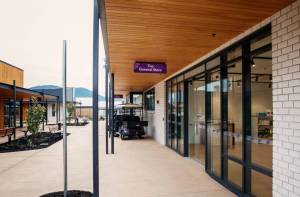
Tasmania’s highly anticipated new dementia village, Korongee, “does not feel like a nursing home” and offers residents significant independence, while at the same time ensuring they are safe and secure, says Mae Collins, whose husband Gary, 62, moved into Korongee earlier this year.
Gary was diagnosed with young-onset dementia five years ago – at the age of only 57.
The ‘village’ aspect was “very important” to the family, who can now be assured that Gary will receive the care and support he needs as his dementia progresses.
“For us as a family, with someone so young, it was a much harder decision to put someone into care and comes with additional complexities,” Mae said in an email to HelloCare.
Korongee, with its more ‘normal’ environment and activities, was more suitable for Gary than traditional secure dementia units, the family strongly believed.
Mae says the move has been freeing for her, and Gary has been happy, on the whole, with the change too.
“I can now be more of a wife to Gary again, letting those at Korongee provide him the care, taking that caring role off my shoulders and giving me the space to enjoy moments with Gary while we can,” Mae said.

Every week, two new residents move into Korongee, Tasmania’s innovative new dementia village which opened its doors earlier this year. The phased opening allows residents time to settle in, but it also helps existing residents adjust to having a new companion in their home.
Eventually eight people will live in each house, and there are three houses on four cul de sacs. However, only two houses are open at this stage, as Korongee takes careful steps forward to increase capacity.
The home is a shake up for Tasmania’s dementia care sector. It not only offers attractive, purpose-built new digs and revolutionises the way staff care for residents, with a focus on supporting and encouraging residents, rather than ticking off a list of tasks, but it also uses world-leading technology to match like-minded residents in each house.
From the time he was diagnosed, Gary understood his illness and how it progressed, and together, he and his wife Mae were able to talk openly about it, and implement changes that helped them both manage as best they could.
However, over the last few years, Gary developed paranoia and delusional episodes. “These were often difficult to deal with,” Mae wrote.
The episodes often occurred in the early hours of the morning, affecting both his and Mae’s sleep, and even though medication helped, Gary eventually had an episode that really frightened Mae.

That was the trigger for Gary to move into residential care, and he did so the very next week.
Though Gary did not recall the incident that prompted his move into care, he was aware that something had changed, and he was still able to be involved in making the decision, just as he had been involved in most other decision making up to that point.
He had always known a move into care might be necessary – “whether he liked it or not”, Mae said.
Gary had had a couple of experiences with respite care in 2019 that left him “very angry” and “confused”, and the family were nervous he would not “settle well” into care.
But on Gary’s suggestion, the family – Mae, Gary and their two children, son Dylan (30 years) and Emily (27) – still looked at six nursing homes with secure dementia units over the last year or so.
They also closely followed the development of Korongee from the moment they heard about it and felt a dementia village “with normal environments and activities” would suit Gary better than traditional dementia homes.
Applications to Korongee coincidentally opened soon after Gary began to experience increased paranoia and delusional episodes, and the family’s tour of the village coincided with Gary’s episode that frightened Mae. The tour became more than just a visit; the family was also evaluating if the village would be a good fit for Gary.

And they decided it was. Gary moved in the following week.
“We never called it a nursing home or care, we called it Korongee or the village, and that was to be his new home,” Mae said.
The move has gone “better than we anticipated”, Mae said.
Because Gary is so young, he can access an NDIS plan, which Mae manages. The two carers who supported Gary at home were able to continue supporting him at Korongee, which has provided reassuring continuity and has enabled Mae to continue working a couple days a week.
Gary has continued to be engaged in his community, he swims and gets out and about.
“He has times of frustration and confusion, however, overall he has settled in well,” Mae said.
Gary’s favourite aspect of Korongee is the cafe, to which he can walk independently and get a mocha. He enjoys the company of Julie, who runs the cafe, and who encourages his love of music and guitar playing “when the cafe is quiet”.
“He also loves helping with watering the gardens and planting vegetables with Tim the gardener.
“We are hoping that when the gym gets up and running that he will also enjoy using that regularly as well,” Mae said.
“The staff are very friendly, not just the carers, but the other support staff as well, from the receptionists, to the cleaners and gardener. They all know Gary by name and make him feel valued.
“The village is already developing a very community-like feel and will only get more so as more residents move in,” Mae explained.
Lucy O’Flaherty, CEO of Glenview, the operator of Korongee, said the resident matching process they have developed with the University of Tasmania is a world first. Residents answer a set of questions that determines their values, likes and dislikes, and other personal traits, and from that, the team determines which residents would be best suited to living together.
“It’s proving to be effective,” Ms O’Flaherty told HelloCare. “There are these natural companionships, and a sense of familiarity, the things people are doing, the conversations they have. The philosophy we hoped to tackle with this matching process seems to be coming to fruition.”
So far, the feedback from residents and families has been “amazing”, though there have been a few teething problems, as they expected.
Staff have, on the whole, adapted to a “huge shift” in the way they deliver care. Though instructed in how different their roles would be at Korongee, the reality has only become clear once staff have been working on site.
Most love the more person-centred approach where staff are guided by the resident’s wishes in the moment, and directing, supporting or encouraging activities, rather than focussing on achieving a list of tasks. Nobody is woken at Korongee either, so the days take on a different rhythm.
However, “a few” staff members haven’t been able to adapt, Ms O’Flaherty admitted.
As residents gradually move into Korongee village, the differences between Glenview’s more traditional home is stark. “It has convinced me we are on the right track,” Ms O’Flaherty said.